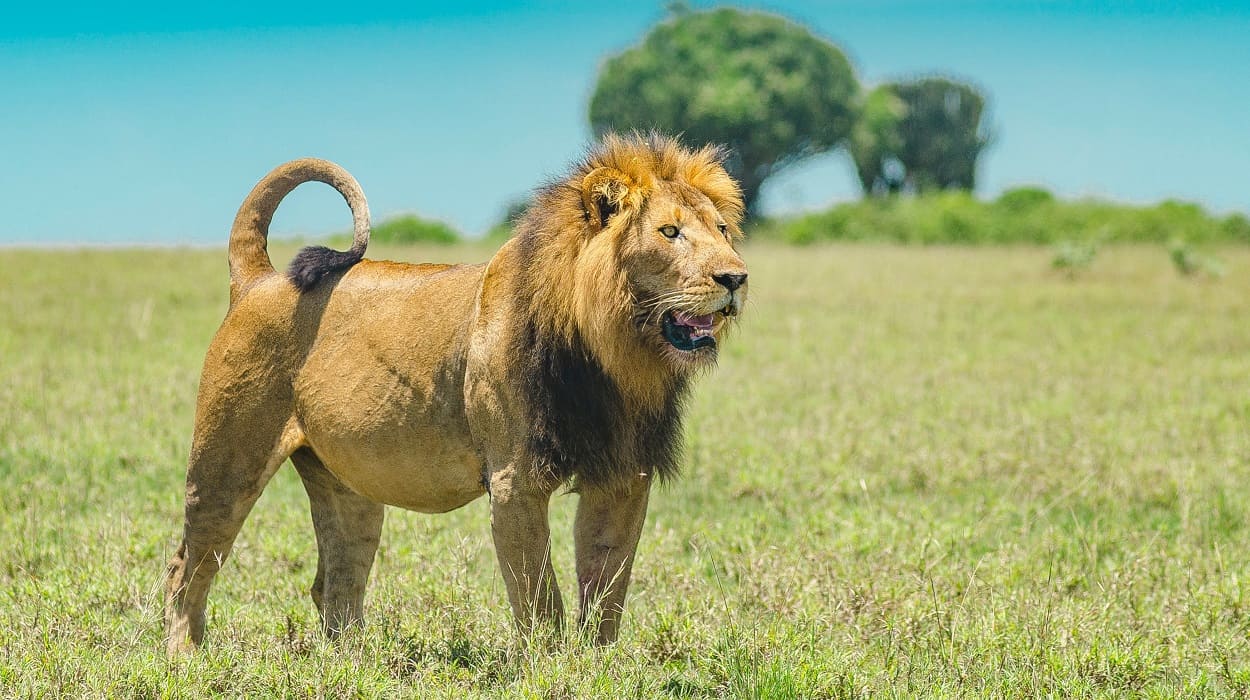
Southern Tanzania

30,893 km²

Miombo woodlands, savanna, rivers

The Rufiji River and boat safaris
Nyerere National Park, formerly Selous Game Reserve, is renowned for its incredible wildlife and diverse ecosystems. One of the park’s highlights is the annual Great Migration, where large herds of wildebeests, zebras, and gazelles move through the park in search of fresh grazing lands. This dramatic journey sees these animals traveling across southern Tanzania, providing a captivating spectacle for safari-goers.
Nyerere National Park is vast, covering a staggering 30,000 square kilometers (11,583 square miles), making it one of the largest game reserves in Africa. Its name pays tribute to Julius Nyerere, Tanzania’s first president. The park’s immense size offers endless landscapes of rugged terrain, dense forests, open savannahs, and winding rivers, creating a rich and diverse habitat for an array of wildlife. With its sprawling terrain and varied ecosystems, Nyerere National Park provides the perfect setting for an authentic, immersive safari.
The park’s diverse ecosystems, ranging from riverine forests to open savannah, are home to a wide variety of wildlife. Visitors can encounter elephants, lions, hippos, crocodiles, and rare species such as the African wild dog. The Rufiji River, the longest river in Tanzania, meanders through the park, offering a unique vantage point for spotting wildlife and providing an essential water source for the animals. The river also creates dramatic encounters, particularly when large herds of animals gather at its banks during the dry season.
The Rufiji River and its tributaries are a major feature of Nyerere National Park. During the migration season, animals often make their way to the river for water, creating spectacular scenes of wildlife interactions. Hippos, crocodiles, and elephants are frequently seen along the riverbanks. The southern section of the park, with its vast floodplains, offers an excellent view of the migration as the animals gather in large numbers to graze, drink, and rest. This is the heart of the park’s wildlife action.
For those seeking privacy and seclusion, Nyerere National Park offers a range of exclusive safari experiences. Private reserves within and around the park provide a more intimate experience, far from the crowds. The park is known for its tranquil atmosphere, allowing visitors to explore its natural beauty in peace. Whether on a luxury safari camp or a walking safari with experienced guides, visitors can immerse themselves in the wilderness and witness the park’s rich biodiversity.
The northern part of Nyerere National Park, closer to the Selous Game Reserve, offers an exciting opportunity for exploring diverse wildlife and landscapes. It is less traversed by tourists, making it an ideal location for those seeking a more off-the-beaten-path adventure. The area is known for its rich biodiversity, including large populations of big cats and wild dogs. Visitors can also explore the quiet corners of the park, where the true wilderness of Tanzania awaits.
The central region of Nyerere National Park, including the areas around the Rufiji River, offers excellent wildlife viewing opportunities throughout the year. This area remains active even when the migration passes through other parts of the park. Visitors can expect regular sightings of elephants, lions, and the famous African wild dog. For a more personalized experience, visitors can opt for stays in luxury safari lodges or private reserves that offer unique experiences, such as river cruises and guided walking safaris, combining adventure and comfort.
Nyerere National Park offers one of Tanzania’s most captivating and thrilling safari experiences. Its vast landscapes of miombo woodlands, expansive savannahs, and winding rivers make it a haven for wildlife lovers and adventure seekers. The park’s untamed beauty, nestled alongside the mighty Rufiji River, sets the perfect stage for an unforgettable safari. One of the most unforgettable moments I experienced was watching a herd of elephants drink from the river, with the sun setting over the horizon — a rare and majestic sight.

Travel Designer
Browse through some of the finest accommodation options

However, we’ll plan your safari around your interests, tastes, and preferences. In addition, we provide honest advice based on first-hand knowledge. Moreover, our goal is to ensure that every aspect of your journey reflects what you truly enjoy. Therefore, you can expect a customized experience that caters specifically to your desires. Furthermore, our expertise will guide you in making the most informed decisions. Ultimately, this approach guarantees a memorable and fulfilling travel experience, ensuring exceptional service, personalized attention, and unique opportunities for adventure.

However, our expert guides and brilliant concierges are hand-picked for their ability to bring your destination to life with care and passion. Furthermore, their extensive knowledge and enthusiasm ensure that every moment of your journey is enriched with local insights. Moreover, they are dedicated to providing an exceptional experience tailored to your preferences. As a result, you can fully immerse yourself in the destination and enjoy a truly unique adventure. Ultimately, their commitment transforms your trip into an unforgettable exploration of the world.

But, we seek out unforgettable experiences that benefit both local communities and the environment. By doing so, we ensure that your adventures not only create lasting memories but also positively impact the places you visit. Additionally, our focus on sustainability and community support helps preserve the natural beauty and cultural heritage of the destinations. Ultimately, this approach allows you to enjoy your journey while contributing to the well-being of both people and the planet, ensuring sustainability, cultural respect, and environmental preservation throughout your travels.
Hence, get inspired by our example trips, and then reach out to plan your adventure. Whether you have specific desires or need guidance, our team of expert travel designers is ready to help. Additionally, we tailor each trip to meet your unique interests and preferences. Therefore, you can be assured of a personalized and exceptional travel experience. Ultimately, we are here to make your dream journey a reality.
Therefore, whatever you want from your tours, our team of expert travel designers are ready to help.

Home Made For You Highlights Where to stay Trip inspiration Where to go When to visit Inspiration Location Area 988 km² Ecosystem Coral Reefs Unique Feature Spice Farms Experience a Tropical Escape on Pemba Island…
All Destination Mount Kilimanjaro Climbing National Parks,Mountain Range 1668 km² Northern Circuit, Kilimanjaro Book OverView Highlights Activities FAQ Safari Packages Parks Nearby Mount Kilimanjaro National Park National Parks,Mountain Range 1668 km² Northern Circuit, Kilimanjaro Mount…
All you need to know about Kilimanjaro National Park Reading time: 6 minutes Oct 16, 2024 A Treasured Landmark The Park is one of Tanzania’s most treasured landmarks and a top destination for visitors. Discover…
Home Made For You Highlights Where to stay Trip inspiration Where to go When to visit Inspiration Location Area 70 meters (approx.) Ecosystem Lush Tropical Forest Unique Feature Coffee Tours Nearby Experience a Refreshing Adventure…
Home Made For You Highlights Where to stay Trip inspiration Where to go When to visit Inspiration Location Area 1,510 km² Ecosystem Savanna and riverine forests Unique Feature The Great Migration Experience a Thrilling Safari…
Where History Meets Exotic Beaches Welcome to Sun, Sand and Spice Zanzibar Island: A Tropical Sanctuary Nestled off Tanzania’s coast in the warm waters of the Indian Ocean, Zanzibar Island provides an unparalleled experience for…
Home Made For You Highlights Where to stay Trip inspiration Where to go When to visit Inspiration Location Area 1,990 km² Ecosystem Montane and tropical rainforests Unique Feature Stunning waterfalls, including the Sanje Falls Experience…
The Land of 1000’s of Elephants Welcome to Home to the Elephants Tarangire National Park is renowned for its majestic Baobab trees, which can grow to an enormous size and boast a unique, iconic shape….
Home Made For You Highlights Where to stay Trip inspiration Where to go When to visit Inspiration Location Area 1,100 km² Ecosystem Coastal and Savannah Unique Feature Beach and Wildlife Combination Experience a Thrilling Safari…
Home Made For You Highlights Where to stay Trip inspiration Where to go When to visit Inspiration Location Area 456 km² Ecosystem Forest and Lake Shore Unique Feature boat safaris and primate sightings. Experience a…
Home Made For You Highlights Where to stay Trip inspiration Where to go When to visit Inspiration Location Area 14 km² Ecosystem Coastal and mangrove forests Unique Feature Historical Swahili architecture and pristine beaches Experience…
OVERVIEW The Ngorongoro Crater, the world’s largest intact and unfilled volcanic caldera, is the main tourist attraction of the Ngorongoro Conservation Area. Renowned for its stunning natural features, it is one of Africa’s Seven Natural…








The best time to visit Nyerere National Park depends on what you want to experience. The dry season, from June to October, is ideal for wildlife viewing as animals gather around water sources, making them easier to spot. The weather is also more comfortable during this period, with less rainfall and pleasant temperatures, making it perfect for game drives and observing the park’s abundant wildlife.
Alternatively, the green season, from November to May, offers lush landscapes and fewer tourists. While there’s more rainfall, this period brings vibrant vegetation, making it a great time for birdwatching and enjoying the park’s stunning beauty. The wet season also offers a quieter, more peaceful experience, perfect for those seeking solitude and a more intimate connection with nature.
Ultimately, both seasons provide unique experiences, so the best time to visit Nyerere National Park depends on whether you prefer a lively wildlife adventure or a tranquil, lush escape.

June-October

November to May
Whatever you want from your adventure in the Tanzania, our team of expert travel designers are ready to help


Therefore, when you book a safari in today’s world, there is much to consider. However, with the right advice and expert planning, you can confidently approach your travel arrangements. Additionally, our experienced team is here to provide guidance. In other words, we ensure that every detail is handled smoothly.
Moreover, if you book to travel with us, your plans are impacted by circumstances beyond your control, then we understand that flexibility is essential. Consequently, we offer options to adjust your reservation or cancel it. As a result, you will receive full credit for future travel expenses. Thus, you can plan your next adventure without worry.
Nyerere National Park is located in the southern part of Tanzania, bordered by the Selous Game Reserve to the west and the Indian Ocean to the east. It is easily accessible from Dar es Salaam, about a 4-5 hour drive away.
The park is home to a wide range of wildlife, including elephants, lions, cheetahs, giraffes, hippos, crocodiles, and various species of birds. It is also renowned for its diverse ecosystems, from savannahs to riverine forests.
The best time to visit is during the dry season, from June to October, when wildlife is easier to spot around water sources like the Rufiji River. The weather is also more comfortable during these months.
Yes, walking safaris are available in designated areas of the park. These safaris provide an intimate and guided way to explore the park’s natural beauty while learning about the ecosystem and wildlife up close.
Nyerere National Park offers a range of accommodations, from luxury lodges and tented camps to more basic campsites. There are also mobile safari camps that follow the wildlife movement, providing a unique and personalized experience.
Yes, boat safaris along the Rufiji River are one of the highlights of the park. These safaris offer unique opportunities to observe wildlife, especially hippos, crocodiles, and birds, from a different perspective.